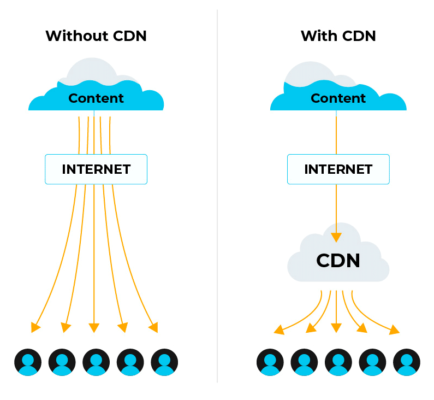Fill form to unlock content
Error - something went wrong!
Stay up to date with the latest IoT and network edge news.
Subscribed.
CDN Servers Bring Remote Coursework to Rural Schools

Connectivity affords access and opportunity in today’s data-centric world. But schools in rural areas often struggle to establish and maintain stable internet connections to acquire that data. As of 2022, only 46% of rural inhabitants worldwide had access to the internet—a number that dips to just 26% in landlocked developing countries. This compares to 82% access for inhabitants of urban centers.
The last couple of years have exposed the connectivity shortfall for rural school districts that were forced to transition to remote online-learning curriculums overnight. But addressing the issue wasn’t as simple as network operators flipping a switching, or issuing grants that subsidize internet access to rural citizens. In many cases the network in those areas just couldn’t support the streaming video and other rich media that teachers wanted to deliver over the internet—if the infrastructure was present at all—according to Brian Hsu, Product Line Manager for NEXCOM International, a leading supplier of network appliances.
So why is there such a disparity between the ubiquitous connectivity of cities and the sparsity you experience in the country? It comes down to cost and bandwidth. Low population density has restricted the rollout of robust connectivity infrastructure in rural areas, because the limited number of subscribers makes it difficult for internet service providers (ISPs) to recoup investments in high-bandwidth network infrastructure. This means that for internet connectivity to be accessible to all rural learners, the cost and performance of rural networking and communications equipment must change.
Today, network-equipment manufacturers are working to solve this challenge using content delivery networks (CDNs) and off-the-shelf rackmount servers.
“A CDN is very important, especially in rural areas, to being able to spread information across multiple locations around the world,” Hsu explains.
Save Cost by Scaling Down Rural Content Delivery
But before considering equipment that can alleviate the bandwidth bottleneck for rural schools, it’s important to understand how data moves from servers to clients, and where current architectures fall short (Figure 1).

Each of the two images below contains a cloud labeled “content,” which is positioned above a group of user icons. You can think of the content cloud as a server that delivers content, data, and/or services to the users, which each represents a client.
The orange lines in the figure represent data flows, which you’ll notice are much longer and more prevalent in the image on the left, without a CDN. That’s because it’s depicting a traditional client-server topology, where an origin server (or, the server where the data originates) provides clients with the data they request on a one-to-one basis.
The image on the right of the figure shows this same data exchange, only optimized with a CDN. A CDN is an architecture that caches data on intermediary servers located close to end users, which means that content is delivered from the origin server once, and then made accessible to multiple users on a local CDN server, which they could even connect to over a local area network (LAN).
In all, the CDN topology reduces latency and networking costs because data can be sent from the origin server once and serve multiple users, says Hsu. It can also help prevent the origin server from being overwhelmed with requests during unforeseen periods of high utilization. For network operators and users, CDNs serve the same purpose as a logistics company’s warehouse or distribution center. For instance, it’s faster and cheaper to transport goods (data) to consumers (clients) who are nearby.
“One of the key benefits of having a #CDN in your #architecture is the remarkable flexibility that it provides you in terms of scaling to meet unforeseen spikes in consumption” – Brian Hsu, @NEXCOMUSA via @insightdottech
Flexibility First for Rural CDNs
CDN servers can be built from almost any rackmount server hardware, but there are special considerations when deploying one on a network in a rural area.
- How many users will it support?
- On average, how much data will be cached on it?
- How will it connect to the origin server?
- And what network will clients use to connect to it?
These are just a few of the questions network operators and school IT departments should ask themselves before implementing a CDN in a rural area, as they will help guide the selection of CDN server hardware. And while there are many options, flexibility is the one feature CDN operators can’t afford to skip on.
That’s why NEXCOM has developed the NSA 7160, a multipurpose 2U rackmount appliance based on two 4th generation Intel® Xeon® Scalable processors. The NSA 7160 features eight PCIe Gen 5 LAN slots that provide up to 2.6 Tbps of Ethernet connectivity. The LAN expansion slots are key to helping end users configure CDNs to their exact needs, while also handling unforeseen traffic spikes, Hsu explains.
“One of the key benefits of having a CDN in your architecture is the remarkable flexibility that it provides you in terms of scaling to meet unforeseen spikes in consumption. With the NEXCOM NSA 7160, it can be customized and configured according to our customers’ needs,” says Hsu.
But just as important as that massive Ethernet throughput is the installed wireless-adapter module that can be used to add Wi-Fi 6 or 5G connectivity to the system. These WAN options combined with the aforementioned LAN configuration options provide network engineers uncapped possibilities when it comes to connecting clients to the CDN.
Aside from the performance of the latest-generation Intel Xeon processors that streamline network routing, switching, and even multimedia processing, the chipsets integrate critical functionality for a rural CDN, such as cryptographic workload acceleration courtesy of Intel® QuickAssist Technology (Intel® QAT), support for a TPM, and a RunBMC baseboard-management controller on the LAN modules that keeps data from being transferred from one failing server to another in the event of network shutdown.
And to ensure that there’s plenty of capacity for all types of coursework and curriculums, the NEXCOM NSA 7160 integrates 16 DDR5 memory DIMMs, a PCIe Gen4 x16 FHFL expansion slot with CXL 1.1 support, and up to seven NEXCOM proprietary NVMe storage adapters for additional data storage.
Class is in Session, Everywhere
At a time when more remote learning is happening than ever, CDNs play a pivotal role in democratizing education in connectivity deserts. And by lowering barriers to network access, they are ensuring that students in rural areas have access to the same opportunities as their city-dwelling counterparts.
High-throughput rackmount appliances like the NEXCOM NSA 7160 are also bringing down those barriers, as they can be transported, plugged in, and configured to the requirements of any end client or deployment environment without sacrificing latency or performance.
Now, no matter where you are, class is in session.
This article was edited by Christina Cardoza, Associate Editorial Director for insight.tech.